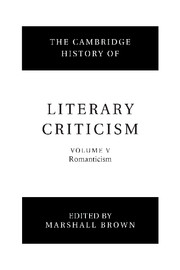Book contents
- Frontmatter
- Introduction
- 1 Classical standards in the period
- 2 Innovation and modernity
- 3 The French Revolution
- 4 Transcendental philosophy and Romantic criticism
- 5 Nature
- 6 Scientific models
- 7 Religion and literature
- 8 Language theory and the art of understanding
- 9 The transformation of rhetoric
- 10 Romantic irony
- 11 Theories of genre
- 12 Theory of the novel
- 13 The impact of Shakespeare
- 14 The vocation of criticism and the crisis of the republic of letters
- 15 Women, gender and literary criticism
- 16 Literary history and historicism
- 17 Literature and the other arts
- Bibliography
- Index
- References
6 - Scientific models
Published online by Cambridge University Press: 28 March 2008
- Frontmatter
- Introduction
- 1 Classical standards in the period
- 2 Innovation and modernity
- 3 The French Revolution
- 4 Transcendental philosophy and Romantic criticism
- 5 Nature
- 6 Scientific models
- 7 Religion and literature
- 8 Language theory and the art of understanding
- 9 The transformation of rhetoric
- 10 Romantic irony
- 11 Theories of genre
- 12 Theory of the novel
- 13 The impact of Shakespeare
- 14 The vocation of criticism and the crisis of the republic of letters
- 15 Women, gender and literary criticism
- 16 Literary history and historicism
- 17 Literature and the other arts
- Bibliography
- Index
- References
Summary
Poetic metaphors and scientific models
The century and a half preceding the Romantic period was marked not only by an unprecedented succession of major scientific discoveries, but also by the rise of entirely new domains of scientific knowledge. From Newtonian mechanics to chemistry, from biology to psychology, each new field disclosed natural phenomena that were increasingly inaccessible to ordinary human observation. Such phenomena had to be apprehended through technological innovations (telescopes, microscopes), and were often only comprehended through the use of mathematical formulas and conceptual models.
Amidst this growing scientific abstraction, Romantic writers have been seen as conducting a valiant but ultimately futile crusade to save the appearances. Goethe insisted that natural objects should not merely be studied objectively – ‘in themselves and in their relation to each other’ – but viewed in relation to the observers themselves. Blake bitterly denounced Newton's mechanistic world-view, and even Coleridge, while professing admiration for Newton's scientific discoveries, deplored the passivity of corporeal bodies in Newton's scheme of nature and, what for him was worse, the passivity of Newton's concept of the mind itself. ‘[T]he Souls of 500 Sir Isaac Newtons would go to the making up of a Shakespeare or a Milton’, he wrote, adding that ‘Newton was a mere materialist – Mind in his system is always passive – a lazy looker-on on an external World.’ The Romantics' suspicion of a scientific approach to nature is best expressed in Wordsworth's line, ‘we murder to dissect’.
Yet such criticism of Newtonian abstraction and materialism does not mean that the Romantics were hostile to science itself.
- Type
- Chapter
- Information
- The Cambridge History of Literary Criticism , pp. 115 - 137Publisher: Cambridge University PressPrint publication year: 2000
References
- 2
- Cited by



